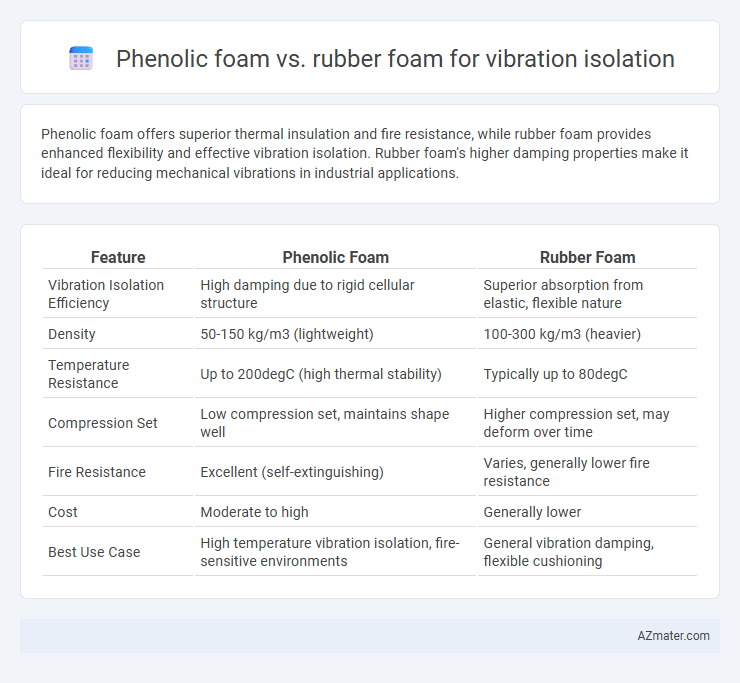Phenolic foam offers superior thermal insulation and fire resistance, while rubber foam provides enhanced flexibility and effective vibration isolation. Rubber foam's higher damping properties make it ideal for reducing mechanical vibrations in industrial applications.
Table of Comparison
| Feature | Phenolic Foam | Rubber Foam |
|---|---|---|
| Vibration Isolation Efficiency | High damping due to rigid cellular structure | Superior absorption from elastic, flexible nature |
| Density | 50-150 kg/m3 (lightweight) | 100-300 kg/m3 (heavier) |
| Temperature Resistance | Up to 200degC (high thermal stability) | Typically up to 80degC |
| Compression Set | Low compression set, maintains shape well | Higher compression set, may deform over time |
| Fire Resistance | Excellent (self-extinguishing) | Varies, generally lower fire resistance |
| Cost | Moderate to high | Generally lower |
| Best Use Case | High temperature vibration isolation, fire-sensitive environments | General vibration damping, flexible cushioning |
Introduction to Vibration Isolation Materials
Phenolic foam and rubber foam serve critical roles in vibration isolation due to their distinct material properties. Phenolic foam offers superior thermal insulation and structural rigidity, making it ideal for environments requiring fire resistance and low weight, while rubber foam excels in flexibility and damping capacity, effectively reducing vibration transmission. Selecting between phenolic and rubber foam depends on specific application demands such as load-bearing, environmental conditions, and frequency range of vibration.
Overview of Phenolic Foam Properties
Phenolic foam offers exceptional thermal insulation, high compressive strength, and excellent fire resistance, making it ideal for vibration isolation in harsh environments. Its closed-cell structure provides low moisture absorption and superior damping characteristics, effectively reducing vibration transmission. Compared to rubber foam, phenolic foam maintains dimensional stability under extreme temperatures and chemical exposure, ensuring long-term performance in industrial applications.
Key Features of Rubber Foam
Rubber foam offers superior vibration isolation due to its high resilience, excellent energy absorption, and flexibility under dynamic loads. Its closed-cell structure provides resistance to moisture and chemicals, enhancing durability in harsh environments. Compared to phenolic foam, rubber foam delivers better sound dampening and shock absorption, making it ideal for applications requiring consistent vibration control.
Acoustic Performance Comparison
Phenolic foam offers superior sound absorption and damping properties, making it highly effective in reducing airborne noise vibrations compared to rubber foam. Rubber foam, while providing excellent vibration isolation due to its elasticity and low dynamic stiffness, often lacks the same level of acoustic attenuation in high-frequency ranges as phenolic foam. The closed-cell structure of phenolic foam enhances its acoustic impedance, resulting in better control of sound transmission and reverberation in vibration isolation applications.
Mechanical Vibration Damping Efficiency
Phenolic foam exhibits superior mechanical vibration damping efficiency due to its rigid, closed-cell structure that dissipates vibrational energy effectively, making it ideal for high-frequency vibration isolation. Rubber foam offers excellent damping for low-frequency vibrations because of its flexible, elastomeric nature that absorbs and isolates mechanical vibrations through shear deformation. Choosing between phenolic and rubber foam depends on the vibration frequency range and specific damping requirements in industrial or automotive applications.
Thermal Insulation Differences
Phenolic foam offers superior thermal insulation due to its closed-cell structure and low thermal conductivity, typically around 0.020 to 0.025 W/m*K, making it highly effective in minimizing heat transfer. Rubber foam, although flexible and excellent for vibration damping, generally has higher thermal conductivity values near 0.035 to 0.050 W/m*K, resulting in less efficient thermal insulation. The choice between phenolic and rubber foam for vibration isolation applications should consider the criticality of thermal performance alongside mechanical damping requirements.
Fire Resistance and Safety Aspects
Phenolic foam offers superior fire resistance due to its low smoke emission, self-extinguishing properties, and high thermal stability, making it ideal for vibration isolation in environments where fire safety is critical. Rubber foam, while providing excellent vibration damping, is generally more flammable and releases toxic fumes when burned, posing higher safety risks in fire-prone applications. Selecting phenolic foam enhances compliance with stringent fire safety standards such as ASTM E84 and UL 94, crucial for industrial and construction uses.
Durability and Longevity Analysis
Phenolic foam offers superior durability and longevity in vibration isolation due to its rigid cell structure and high thermal stability, resisting compression set and mechanical fatigue better than rubber foam. Rubber foam, while flexible and effective for damping vibrations, tends to degrade faster under prolonged stress and environmental exposure, leading to reduced lifespan. The longevity of phenolic foam in harsh industrial applications makes it a preferred choice for consistent performance over time compared to rubber foam.
Application Suitability for Phenolic vs. Rubber Foams
Phenolic foam offers excellent vibration isolation in high-temperature environments and chemical-resistant settings, making it suitable for industrial equipment and automotive applications requiring thermal stability. Rubber foam excels in applications demanding superior flexibility and resilience, such as electronics cushioning, HVAC systems, and sports gear, where impact absorption and durability are critical. Phenolic foam's rigid structure limits its use in dynamic vibration scenarios compared to the versatile and softer rubber foam ideal for broad vibration dampening needs.
Cost-Effectiveness and Sustainability
Phenolic foam offers superior fire resistance and thermal insulation but comes at a higher initial cost compared to rubber foam, which provides excellent vibration isolation with greater elasticity and lower price points. Rubber foam is often more cost-effective for large-scale applications due to its durability and ease of installation, while phenolic foam contributes to sustainability by being made from renewable resources and exhibiting a longer lifecycle with lower environmental impact. Choosing between phenolic and rubber foam depends on balancing upfront investment with long-term sustainability and specific vibration isolation requirements.

Infographic: Phenolic foam vs Rubber foam for Vibration isolation
 azmater.com
azmater.com